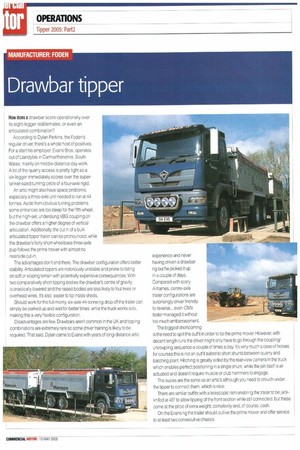How does a drawbar score operationally over its eight-legger stablemates, or even an articulated combination?
Page 58

If you've noticed an error in this article please click here to report it so we can fix it.
According to Dylan Perkins, the Foden's regular driver, there's a whole host of positives. For a start his employer, Evans Bros, operates out of Llandybie in Carmarthensh ire, South Wales, mainly on middle-distance day work. A lot of the quarry access is pretty tight so a six-legger immediately scores over the supertanker-sized turning circle of a four-axle rigid.
An artic might also have space problems, especially a three-axle unit needed to run at 44 tonnes. Aside from obvious turning problems some entrances are too steep for the fifth wheel, but the high-set, underslung VBG coupling on the drawbar offers a higher degree of vertical articulation. Additionally, the cut in of a bulk articulated tipper trailer can be pronounced, while the dram/oar's fairly short wheelbase three-axle pup follows the prime mover with almost no nearside cut-in.
The advantages don't end there. The drawbar configuration offers better stability. Articulated tippers are notoriously unstable and prone to listing on soft or sloping terrain with potentially expensive consequences. With two comparatively short tipping bodies the drawbar's centre of gravity is drastically lowered and the raised bodies are less likely to foul trees or overhead wires. It's also easier to tip inside sheds.
Should work for the full-monty, six-axle 44-tonne rig drop off the trailer can simply be parked up and wait for better times while the truck works solo, making this a very flexible configuration.
Disadvantages are few. Drawbars aren't common in the UK and tipping combinations are extremely rare so some driver training is likely to be required. That said, Dylan came to Evans with years of long-distance artic
experience and never having driven a drawbar rig but he picked it up in a couple of days. Compared with scary A-frames, centre-axle trailer configurations are surprisingly driver friendly to reverse... even CMS tester managed it without too much embarrassment.
The biggest shortcoming is the need to split the outfit in order to tip the prime mover. However, with decent length runs the driver might only have to go through the coupling/ uncoupling sequence a couple of times a day. It's very much a case of horses far courses:this is not an outfit suited to short shunts between quarry and batching plant. Hitching is greatly aided by the rear-view camera in the truck which enables perfect positioning in a single shunt, while the pin itself is air actuated and doesn't require muscle or club hammers to engage.
The suzies are the same as an artic's although you need to crouch under the tipper to connect them, which is nice.
There are similar outfits with a telescopic ram enabling the trailer to be jackknifed at 450 to allow tipping of the front section while still connected, but these come at the price of extra weight, complexity and, of course, cash.
On the Evans rig the trailer should outlive the prime mover and offer service to at least two consecutive chassis.














































































































































































































